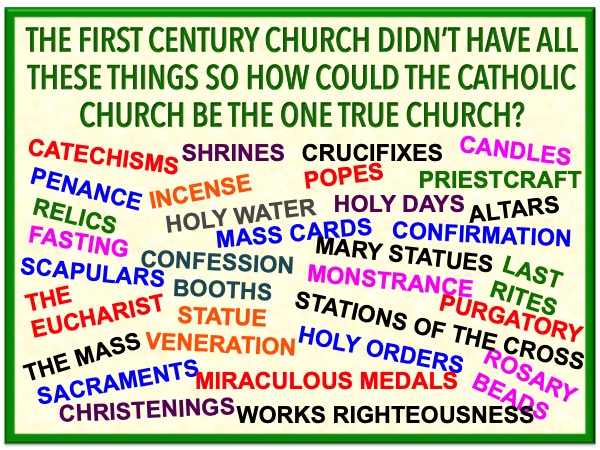Unbiblical Inventions Of The Catholic Church

Just to avoid Catholic knee-jerk reactions to what I am going to point out here, by “unbiblical” I mean things that were not practiced or taught by the early Church of the New Testament. Sure, you can find something in the Old Testament to seemingly justify various Catholic teachings and practices but those are often dishonest equivalencies such as claiming that the two winged cherubim on the ark of the covenant is justification for Catholic statues, which it most certainly is NOT. God commanded Moses to make ONE ark and TWO cherubim. God NEVER commanded Catholics or even the first century Church to make ANY statues of Mary or others. And yet Catholics have made literally millions of statues, not realizing that they are mimicking pagan idol worshipers in their use of religious statues in the practice of their religion.
So here is a list of many of the UNBIBLICAL Catholic inventions:
- a sacramental system
- holy water
- the mass
- the eucharist
- transubstantiation
- the sign of the cross
- statue veneration
- christenings
- miraculous medals
- confession booths
- confession to a priest
- sacrificial priesthood
- religious candles
- religious clothing
- penance
- relics
- scapulars
- incense use
- shrines
- mass cards & masses for the dead
- crucifixes
- monstrances
- stations of the cross
- praying novenas
- praying the rosary
- celebrating Lent
- celebrating Ash Wednesday
- celebrating Christmas
- celebrating Easter
- celebrating All Souls Day
- celebrating All Saints Day
- belief in the assumption of Mary
- belief in the immaculate conception
- holy orders
- holy days of obligation
- purgatory
- indulgences
- treasury of merit
- rosary beads
- altars in church meeting places
- last rites (a.k.a. extreme unction)
- confirmation ceremonies
- first holy communion ceremonies
- mary statues
- saint statues
- saint canonization
- calling church leaders “father”
- calling bishops “popes”
- calling popes or bishops “holy father”
- classes of Christians called popes
- classes of Christians called priests
- classes of Christians called nuns
- classes of Christians called cardinals
- classes of Christians called altar boys
- classes of Christians called altar monks
- specialized buildings called monasteries
- specialized buildings called convents
- establishing political embassies around the world
- a magisterium
- the idea of oral tradition superseding Scripture
- secret societies like Opus Dei or the Jesuits
- praying to mediators in Heaven other than Jesus
- religious headquarters on earth (such as the Vatican)
- torturing and murdering people considered heretics
- a false works-righteousness plan of salvation
The true Church, as described in the pages of the New Testament, was a far simpler entity than the religious monstrosity that is Catholicism. There was no massive clerical hierarchy. There was no 900 page Catholic Catechism. In fact, there were no Catholics – just Christians, brothers and sisters in Christ. Most gatherings of these believers were in homes, not in big fancy expensive buildings. Usually each local church was overseen (but not necessarily tightly controlled) by a plurality of elders. There were no popes and no priests. Communion was a memorial service commemorating the death and resurrection of the Lord Jesus Christ and also celebrating the future wedding feast of the Lamb in Heaven some day. And communion was celebrated with ordinary bread, not some round wafer patterned after the sun god to be paraded around in a starburst-patterned “monstrance” that pagan sun god worshipers would use. Ironically, the persecuted underground churches that we hear about around the world today are more like the first century church than what we see in both Catholic and Protestant churches nowadays. Something to think about.
Our website has an entire section dedicated to sharing biblical information “About Church” that we encourage you to examine. — RM Kane